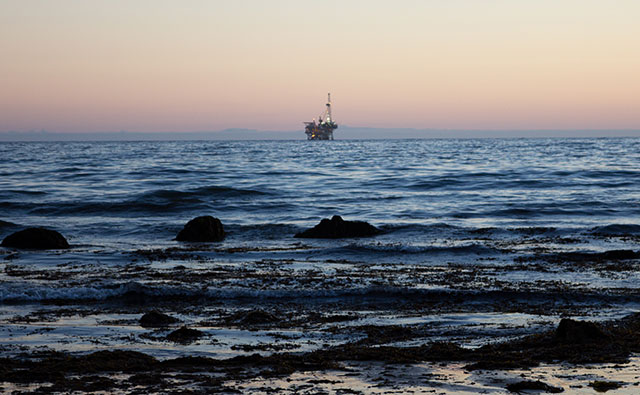
Part of the Series
Planet or Profit
Honest, paywall-free news is rare. Please support our boldly independent journalism with a donation of any size.
In two legal settlements hailed by environmentalists as victories for marine wildlife, federal regulators agreed on January 29 to place a moratorium on new permits for offshore fracking off the coast of California while they assess the potential environmental impacts of the practice.
Separate settlements reached between two environmental groups and the US Interior Department require regulators to complete a “programmatic environmental assessment” of hydraulic fracturing, or fracking, operations in Pacific waters by May 28. The public will have 30 days to comment on the draft assessment, and regulators are prohibited from authorizing offshore fracking until the review is complete.
“Every offshore frack puts coastal communities and marine wildlife at risk from dangerous chemicals or another devastating oil spill,” said Kristen Monsell, an attorney for the Center for Biological Diversity. “Once federal officials take a hard look at the dangers, they’ll have to conclude that offshore fracking is far too big of a gamble with our oceans’ life-support systems.”
In July 2013, a Truthout investigation revealed that federal regulators had quietly approved several fracking operations at oil drilling platforms off the coast of Santa Barbara, and The Associated Press published a similar report about a week later. The revelations alarmed environmentalists and sparked protests across California as lawmakers and the California Coastal Commission launched probes into the practice.
Documents released to Truthout and environmentalists under the Freedom of Information Act revealed that regulators had approved more than a dozen offshore fracking operations in Pacific waters under simple permit modifications that were “categorically excluded” from the environmental reviews typically required by federal law.
The use of categorical exclusions has been under intense scrutiny since 2010, when the media learned that regulators used the exemption to approve BP’s lease on the Deepwater Horizon in 2009, one year before the drilling platform suffered a deadly explosion that caused the massive oil spill in the Gulf of Mexico.
Internal documents also showed that regulators scrambled to learn the scope of offshore fracking and the rules regulating the practice – including the disposal of chemical-laden wastewater – as information requests from Truthout and others came in.
In 2015, the Center for Biological Diversity filed a lawsuit in federal court against the Bureau of Ocean Energy Management and Bureau of Safety and Environmental Enforcement, the two Interior Department agencies that regulate offshore oil and gas drilling in federal waters, accusing regulators of “rubber-stamping” permits to frack wells off the coast of California without conducting environmental reviews or consulting the public.
Another group, the Santa Barbara-based Environmental Defense Center, filed its own lawsuit in late 2014, challenging 53 permits for fracking and “acid well stimulation” on similar grounds. The settlements announced on January 29 resolve both lawsuits.
Fracking involves injecting sand, water and chemicals at extremely high pressure into rock formations under the seabed to break up rock and release oil or gas. Acid stimulation and “acid fracturing” is the injection of highly corrosive acids for similar purposes. Acid treatments and a fracking technique known as a “frack-pack” are both used to stimulate oil flow and complete drilling in old offshore wells in the Pacific Ocean and Gulf of Mexico.
“These practices are currently being conducted under decades-old plans with out-of-date or nonexistent environmental analysis, and this settlement will finally force the federal government to consider their impacts in detail with a transparent process open to public review and input,” said Brian Segee, a senior attorney at the Environmental Defense Center.
Regulators and the industry have said that “frack-packs” are safe and much smaller than the unconventional fracking techniques that sparked recent oil and gas booms and ignited a national controversy onshore.
Environmentalists, however, point out that the oil and gas industry is allowed to dump 9 billion gallons of wastewater into the Pacific Ocean every year, including wastewater from fracking operations. A 2014 report by the Center for Biological Diversity found that at least 10 chemicals commonly found in fracking wastewater could harm or kill marine wildlife such as sea otters and fish.
In response to petitions from environmentalists, the Environmental Protection Agency issued a rule in 2014 requiring offshore drillers in Pacific waters to report any fracking chemicals they dump overboard.
Press freedom is under attack
As Trump cracks down on political speech, independent media is increasingly necessary.
Truthout produces reporting you won’t see in the mainstream: journalism from the frontlines of global conflict, interviews with grassroots movement leaders, high-quality legal analysis and more.
Our work is possible thanks to reader support. Help Truthout catalyze change and social justice — make a tax-deductible monthly or one-time donation today.